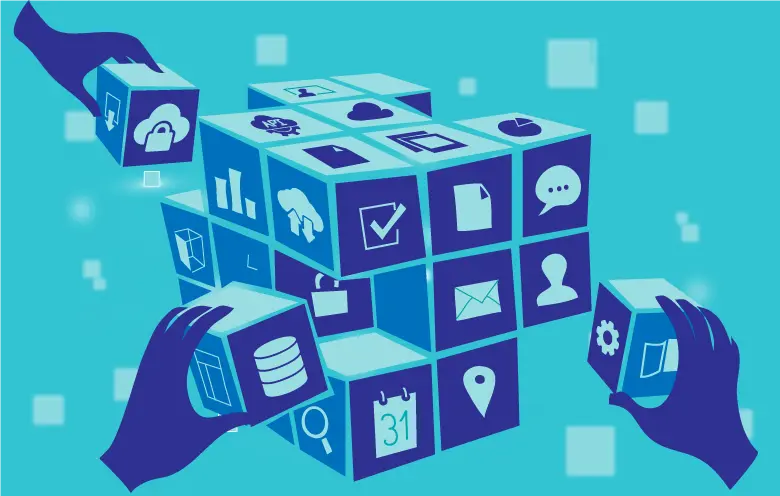In the world of software development, the way we design and develop applications has come a long way. As a business owner, you are trying to navigate the ever-changing technological landscape while keeping up with the demands of your customers. You need a solution that scales, evolves and adapts quickly to meet all these demands. Luckily, the microservices architecture saves the day with its superpowers, eliminating all your troubles.
The popularity of developing microservices solutions is on the rise due to its remarkable ability to overcome the limitations of traditional monolithic architectures. Unlike monolithic applications, a microservice architecture is composed of small, independent processes that communicate with each other. This allows for the self-contained and independent deployment of services.
Walmart Canada’s microservices implementation increased conversion rates, reduced downtime, and 20-50% cost savings because the company could switch to cheaper virtual servers.
What is microservices architecture?
Microservices architecture is a modern approach to application development that involves breaking down a complex application into small, independent services that can be developed, deployed and scaled independently.
Each service performs a specific function and communicates with other services using well-defined APIs. This approach allows for increased flexibility, scalability and fault tolerance. This is because changes to one microservice do not impact other services. Moreover, failures in one microservice do not affect the entire application.
How do microservices solve monolithic application problems?
Monolithic applications are the traditional approach to application development from many years. However, they come with inherent challenges such as maintenance difficulty, scaling and reduced fault tolerance. In response, the new approach has emerged microservices development. Microservices are modular and loosely coupled, making them easier to maintain and update.
Traditional monolithic applications have several problems that can make them difficult to develop, deploy and maintain, including:
- Tight coupling
- Limited scalability
- Long release cycles
Let’s explore how microservices architecture addresses monolithic application challenges.
Migrating to microservices development offers a viable solution to these issues by breaking down the application into smaller, self-contained modules. This enables greater scalability, easier maintenance and improved development cycle.
Microservices offer better insights into application performance than monolithic architectures. Monolithic architectures make it challenging to identify the root cause of an issue, whereas microservices isolate each component. This makes it easier to pinpoint and debug problems. Migrating from monoliths to microservices can also lead to better resource utilization and cost savings, as microservices can be scaled independently as needed.
Additionally, microservices can be written in different programming languages, depending on the application’s specific requirements. This technology independence and portability result in enhanced flexibility and adaptability, enabling organizations to respond quickly and efficiently to changing market demands.
To know more about microservices and its benefits, you can refer to our another blog.
Why is the microservices architecture popular in modern software development?
To meet their complex application development needs, more and more organizations are turning to microservices architectures. It offers several advantages over a traditional monolithic architecture. These include:
Increased resilience and fault tolerance: Microservices do not crash the entire application. It is easier to optimize performance for each component and understand where slowdowns come from. This makes it easier to debug and fix issues.
Faster time to market: As microservices can be developed, tested and deployed independently, new features can be brought to market faster. DevOps and microservices work well together. Microservices improve the DevOps productivity team by embracing a common toolset for both development and operations.
Improved Security: By breaking down an application into smaller, independent services, microservices can limit the impact of security issues and make it easier to manage security at the service level.
What are the main characteristics of microservices-based applications?
Microservices-based applications have several characteristics that distinguish them from traditional monolithic applications. These include:
1. Loosely coupled – Since each service exists independently of the other, communication between them should be done through asynchronous messaging systems such as a message queue. This makes the services loosely coupled and independent of each other, which allows for faster updates and scalability.
2. Highly maintainable code – Due to its decoupled approach, microservice applications are made up of smaller, more maintainable code. This makes it easier for developers to update, debug and maintain the application. The services can be written in different programming languages using different technologies.
3. Modular design – The modular design of microservices-based applications breaks down the application into independent microservices, allowing for flexibility and scalability without affecting the rest of the application. This approach improves fault tolerance, simplifies maintenance and is popular for developing modern, cloud-native applications.
4. Highly resilient – Unlike monolithic applications, microservices can still be operational, even if one component fails. This is because each component can handle its own failure without affecting the other components.
5. Platform independent – Since microservices use lightweight protocols, they can be easily moved from one platform to another without significant changes or reworking. Microservices can be deployed on different platforms, including on-premises, in the cloud, or in a hybrid environment.
Popular use cases for microservices architecture
Microservices are an ideal solution for applications with multiple language support, scalability and flexibility. Some of the most common use cases for microservices architecture include:
1. Authentication and authorization are essential components of any user login application. Microservices architecture is an ideal solution for implementing such systems in multiple languages. Each microservice can be written in the language of your choice, which allows for easy integration with the application and better performance.
2. E-commerce websites require robust and scalable systems to handle large traffic and complex payment processing. Microservices allow different technologies to be used for different services, such as payment processing, shopping cart and inventory management. This makes it easier to manage the website, ensure smooth operations and improve customer experience.
3. Chatbots are becoming increasingly popular for customer support and routine tasks. Microservices are perfect for developing chatbot services as different services can be written in different languages. This approach makes it easier to scale the system, integrate with other services and provide better performance.
4. Image processing is a complex task that requires significant computational resources. Microservices can break down processing tasks into smaller services that can be written in different languages. This approach allows for better performance, scalability and easier maintenance.
5. IoT applications generate a vast amount of data from various devices. Microservices can help manage this data by breaking it down into smaller, manageable chunks.
Microservices success stories from the real world
Let us gain insights from real-world examples of industries that have successfully implemented these technologies and achieved significant results.
1. Netflix: One of the best-known examples of a company that successfully implemented a microservices architecture. They have over 600 microservices that make up their streaming platform. This architecture allows them to handle their massive user base and constantly roll out new features and updates.
2. Amazon: Amazon has been using the microservices architecture for many years. Each of their services, such as Amazon Web Services (AWS) or Amazon Prime, is made up of many microservices that work together to provide a seamless user experience.
3. Uber’s entire backend is built on a microservices architecture. Each microservices is responsible for a specific function, such as processing payments or matching drivers with riders. This architecture allows Uber to quickly scale its platform to meet users’ demands.
4. Airbnb uses a microservices architecture to handle the platform complexity. Each microservice is responsible for a specific function, such as handling reservations or managing payments. This architecture allows them to quickly add new features and scale their platform as needed.
5. Coca-Cola modernized its infrastructure, improved scalability, flexibility and innovation by developing microservices solutions. Migrating to microservices also allowed the company to take advantage of cloud-based technologies, such as serverless computing, to reduce costs and improve scalability.
Embrace microservices and stay ahead of the curve
Microservices development has become the future of application development, providing a range of benefits. Companies that fail to embrace this new approach risk being left behind by their competitors, who are leveraging microservices to build more agile and innovative applications. With the right strategy, tools and mindset, organizations can unlock the full potential of microservices and create applications that meet the needs of today’s dynamic business environment.




